One Rell of a Good Time
Hartford (Google Maps location)
December 4, 2010
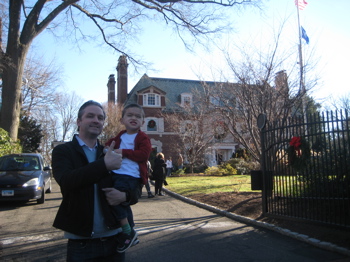 I’ve made mention before about how I get a little thrill out of getting to visit rarely open museums (or in this case, museum-like things). Each time I do feels like a big win for me. I’ve had the Governor’s Residence on my CTMQ radar for several years now. As you can imagine, it’s not exactly open for visitors due to security reasons. (Although, during the Governor M. Jodi Rell years I’ve heard she almost never stayed here, preferring the long drive out Route 44 to her home in Brookfield.)
I’ve made mention before about how I get a little thrill out of getting to visit rarely open museums (or in this case, museum-like things). Each time I do feels like a big win for me. I’ve had the Governor’s Residence on my CTMQ radar for several years now. As you can imagine, it’s not exactly open for visitors due to security reasons. (Although, during the Governor M. Jodi Rell years I’ve heard she almost never stayed here, preferring the long drive out Route 44 to her home in Brookfield.)
I have just learned that tours are available upon request and reservation… Something I didn’t know. It was probably pretty easy to do this during the Rell years because she was so invisible. Now that I think about it, she really didn’t do anything impactful during her tenure as Governor either, so that makes sense. She did sort of just fall into it after her predecessor went to federal prison, but beyond legalizing gay marriage and doubling fishing and state park fees, I’m at a loss.
 But, CTMQ is not a place for political discussions. (Please. I know Jodi had to deal with a democratic house and senate and she vetoed tax hikes and all that .)
But, CTMQ is not a place for political discussions. (Please. I know Jodi had to deal with a democratic house and senate and she vetoed tax hikes and all that .)
As per annual tradition, Rell opened up the Governor’s Residence for three days in early December for several hours each day. Who knows if the next Governor will continue the tradition? It’s easy to proclaim “budget cuts” and shut the whole thing down – even if it appears most of the work and money was donated by sponsors. (Maybe, that’s a little murky… did they just donate their time and talent, or the actual materials? I don’t know.)
 I convinced Hoang that we should get to the mansion at or near the opening time, if only to not have to wait in line out in the cold with Damian. Amazingly, she was game and we actually got out of the house before 10AM on a Saturday! A Christmas miracle. Although Hoang did mention she was excited to go, if only for the chance to peek inside Jodi’s closets to see if it is “full of turtlecks and dickies like I think” Fortunately for us, the mansion is only about 10 minutes from our house over on Prospect Avenue.
I convinced Hoang that we should get to the mansion at or near the opening time, if only to not have to wait in line out in the cold with Damian. Amazingly, she was game and we actually got out of the house before 10AM on a Saturday! A Christmas miracle. Although Hoang did mention she was excited to go, if only for the chance to peek inside Jodi’s closets to see if it is “full of turtlecks and dickies like I think” Fortunately for us, the mansion is only about 10 minutes from our house over on Prospect Avenue.
Prospect Avenue, by the way, is always a fun road to drive down with out-of-towners. Starting at the northern end near the University of Hartford at Albany Avenue, there is a much talked about brownstone wall. (I know that sounds kind of dumb, but people really DO talk about that wall). Anyway, the drive south passes by a mile’s worth of impressive mansions of many different architectural styles like this Tudor and this Colonial and the Georgian revival Governor mansion in question. It’s fun to note that (as you drive south), the houses on the left are in Hartford and the ones on the right are in West Hartford. Okay, that’s not really that fun, but I still do it.
 The Governor’s Residence is the last house on the left before the intersection with Asylum Avenue. (It’s easy to spot with its black fencing and American flag.) So if you didn’t know that this mansion (which doesn’t really stand out at all on the Avenue of mansions) was the Governor’s mansion, next time you’re enjoying a day at Elizabeth Park (CTMQ’s Elizabeth Park history tour here), now you can drop a new fact on your friends and family.
The Governor’s Residence is the last house on the left before the intersection with Asylum Avenue. (It’s easy to spot with its black fencing and American flag.) So if you didn’t know that this mansion (which doesn’t really stand out at all on the Avenue of mansions) was the Governor’s mansion, next time you’re enjoying a day at Elizabeth Park (CTMQ’s Elizabeth Park history tour here), now you can drop a new fact on your friends and family.
Oh, and I should note that any drive down Prospect Avenue should end at the wonderful Spigot Café on Prospect at West Boulevard. Tell Johnny I said hello.
Back to our mansion visit. We arrived about 10 minutes after it opened and a line was just beginning to form. The state police managing the traffic flow were unbelievably personable. It was sort of weird, but appreciated. We walked right up to the front  door and immediately noticed the place was crawling with security and volunteers. The security detail was right out of central casting: Burly shaved-head guys in black suits with hands clasped in front. Merry Christmas.
door and immediately noticed the place was crawling with security and volunteers. The security detail was right out of central casting: Burly shaved-head guys in black suits with hands clasped in front. Merry Christmas.
The tour was nothing more than walking into the foyer, turning right through the library, then left through the sun room, across the back room into the dining room and then back out the front door. The entire process was done in 12-15 minutes and if we were alone, it would have been more like 4 minutes. But I’m not complaining, as I think the whole idea is pretty darn cool.
Of course the house was decorated for the holiday- err, Christmas and all the decorating was done by local nurseries and businesses. There were several Christmas trees and all the decorating was simply perfect. Martha Stewart style all around. It was funny, since I was taking pictures of everything all the volunteers throughout the little tour kept asking me if I had any questions. They assumed I really cared about how a certain tree was decorated or wanted to know some hackneyed anecdote about the governor’s childhood memories. No, just getting photographic content for my blog, ma’am.

This picture was prominently displayed. Lord Xenu is pleased.
From the state’s website: “This stately and gracious house has been home to Connecticut’s governors and their families since 1943. The house was originally built in 1909 for George C.F. Williams, a Hartford physician and industrialist. It was designed in the Georgian Revival style by the Boston-based architectural firm of Andrews, Jacques & Rantoul and built at a cost of $337,000. In 1916, Hartford architects Smith & Bassett designed the north and south wing additions. The three-story home originally stood on 14 acres that included a grass tennis court, a greenhouse and a number of out buildings. It remained in the Williams family until 1940.
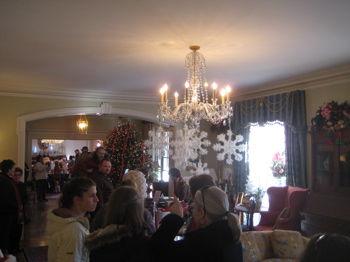 The property was acquired by the State of Connecticut in 1943. The first “official” occupants, Governor Raymond E. Baldwin and his family, moved into the house in 1945. Today, the 19-room residence sits on four acres and has 15,000 square feet of living space with nine fireplaces, nine bathrooms, a pool and a pergola. The Governor’s Residence is listed on the National Register of Historic Places.
The property was acquired by the State of Connecticut in 1943. The first “official” occupants, Governor Raymond E. Baldwin and his family, moved into the house in 1945. Today, the 19-room residence sits on four acres and has 15,000 square feet of living space with nine fireplaces, nine bathrooms, a pool and a pergola. The Governor’s Residence is listed on the National Register of Historic Places.
What’s a house without a pergola? After we entered the house and were regaled by the Coast Guard men’s choral group, we slowly made our way through the foyer and then – lo and behold! – Governor M. Jodi Rell appeared from around a corner and engaged in small talk while I posed for a picture with her and Damian. No thumbs up from the outgoing governor though. I must make note of her skin though; it was very nice for an older woman with a stressful job. I was impressed, but didn’t dare touch her cheek.
Although I think my story would be a bit more interesting had I done that.

I expect Rell to replace her Travolta picture with this one.
After the house became too expensive for the Williams family to maintain, the house then stood vacant for several years, though it was briefly used as a convalescent unit by the Hartford Hospital. Let’s learn some more official history of the house while enjoying the beautiful pictures of the decorated lower level.
 The idea of having a residence for the Chief Executive was first suggested in 1943 by Francis S. Murphy, the publisher of the now defunct Hartford Times. Governor Robert A. Hurley was living in a modest home on Outlook Avenue and Murphy, among others, thought that the Governor ought to live in a house more suited to his high office. After all, 45 states have governor’s residences. Since the Governor himself, with a salary of only $4,600, couldn’t afford such a house, a Search Committee was formed. After reviewing 30 properties, the Committee decided that the old Williams estate, even though it was run down, would serve admirably as the official residence. The state acquired it by paying $39,500 to Williams estate in lieu of back taxes. Another $75,000 was allocated for renovations that were undertaken by Hartford architect Carl J. Malmfeldt. The work took over two years to complete.
The idea of having a residence for the Chief Executive was first suggested in 1943 by Francis S. Murphy, the publisher of the now defunct Hartford Times. Governor Robert A. Hurley was living in a modest home on Outlook Avenue and Murphy, among others, thought that the Governor ought to live in a house more suited to his high office. After all, 45 states have governor’s residences. Since the Governor himself, with a salary of only $4,600, couldn’t afford such a house, a Search Committee was formed. After reviewing 30 properties, the Committee decided that the old Williams estate, even though it was run down, would serve admirably as the official residence. The state acquired it by paying $39,500 to Williams estate in lieu of back taxes. Another $75,000 was allocated for renovations that were undertaken by Hartford architect Carl J. Malmfeldt. The work took over two years to complete.
This next bit is rich.
The first occupants were Governor Raymond E. Baldwin and his family, who moved in during September 1945. But the original restoration was less than successful and featured mismatched furniture in a wide variety of styles.
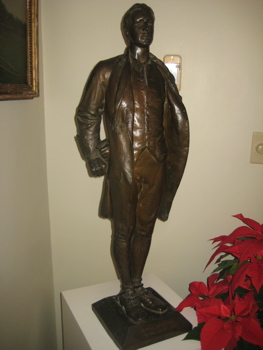 According to Governor Baldwin, the legislature had furnished his house politically, parceling out patronage to merchants in various towns by allowing each one to purchase some of the furniture. The results were such that Mrs. Baldwin told her husband that she would not move in. A neighbor, Beatrice Fox Auerbach, owner of G. Fox & Co., came to the rescue. She removed the offending furniture and brought in her staff of decorators to furnish the Residence with 18th century antiques and handcrafted reproductions. The finest pieces were made by Hartford cabinet maker Nathan Margolis, whose shop had already executed prestigious commissions for John B. Rockefeller, the DuPonts, and Yale University.
According to Governor Baldwin, the legislature had furnished his house politically, parceling out patronage to merchants in various towns by allowing each one to purchase some of the furniture. The results were such that Mrs. Baldwin told her husband that she would not move in. A neighbor, Beatrice Fox Auerbach, owner of G. Fox & Co., came to the rescue. She removed the offending furniture and brought in her staff of decorators to furnish the Residence with 18th century antiques and handcrafted reproductions. The finest pieces were made by Hartford cabinet maker Nathan Margolis, whose shop had already executed prestigious commissions for John B. Rockefeller, the DuPonts, and Yale University.
Whoa, so much to take in there. Today, the whole place is uniformly lovely and properly outfitted with boring old furniture. Well, gee Mrs. Baldwin, thanks for personifying the New England liberal elite archetype. You get a free house to live in and you simply cannot move in because the dresser doesn’t match the headboard? Though, at least her husband seemed like a pretty good gov.
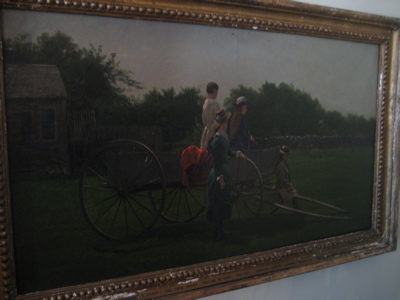
A beautiful William Hart original
This Beatrice Fox Auerbach lady pops up here and there on CTMQ. She really was quite the woman back in the mid-20th century. While a small part of her story is out at the Auer Farm in Bloomfield (CTMQ Visit here), she was much, much more influential in Hartford and for basic civil rights. From 1938 to 1965, Beatrice Fox Auerbach was chief executive of G. Fox & Company, Hartford’s premier retail outlet, and the sixth largest  privately owned department store in the country. She was a pioneer in labor relations. Among her innovations was the establishment of a 5-day work week, and employee medical and retirement plans; she was the first in U.S. retailing to hire blacks in other than menial jobs and she provided advancement opportunities for women. Mrs. Auerbach fostered fierce loyalty among her employees and became a pioneer in the realm of employee benefits such as retirement plans, in-store hospitals, loans to employees in need, paid vacations, and at-cost meals.
privately owned department store in the country. She was a pioneer in labor relations. Among her innovations was the establishment of a 5-day work week, and employee medical and retirement plans; she was the first in U.S. retailing to hire blacks in other than menial jobs and she provided advancement opportunities for women. Mrs. Auerbach fostered fierce loyalty among her employees and became a pioneer in the realm of employee benefits such as retirement plans, in-store hospitals, loans to employees in need, paid vacations, and at-cost meals.
You can read all about Fox here, especially the last paragraph about the local I-84/91 interchange Hartford urban legend about Fox. Sorry Governor Rell, but even you must admit that Mrs. Fox was a more compelling figure in Connecticut history.
After Fox made the joint more presentable, the Governor invited the public to tea and 5,000 people showed up (the Governor, however, had strained his back and was unable to leave his bed to greet the guests).
Today, the Residence serves as a site for many official functions of the Governor and is an extension of that office. Conferences are held with legislators, business and civic leaders, and social functions are scheduled for residents from Connecticut as well as other states and countries. The Residence is also made available to non-profit organizations and there are guided public tours and an annual holiday open house.

Yes, Damian stole the dog’s bone.
Which brings us back to our holiday open house tour. While Damian was busy with Santy Claus and noting all the stuffed dogs in the dining room, I learned a bit more about the rooms themselves. The “paneling” in the foyer of the Governor’s Residence is actually some of the finest trompe l’oeil in the country. It was painted by the nationally known artist John Canning, who is also  responsible for the exquisite trompe l’oeil work in the Connecticut State Capitol. The funny thing is that John Canning (and his studio artists) are a current, present day thing. The guy is super talented, but it was very surprising to learn that he just did this work in the last decade or so. Having just looked at his portfolio, I’m blown away: Grand Central terminal restoration, US Capitol work, on and on and on. And he’s right here in Cheshire!
responsible for the exquisite trompe l’oeil work in the Connecticut State Capitol. The funny thing is that John Canning (and his studio artists) are a current, present day thing. The guy is super talented, but it was very surprising to learn that he just did this work in the last decade or so. Having just looked at his portfolio, I’m blown away: Grand Central terminal restoration, US Capitol work, on and on and on. And he’s right here in Cheshire!
The library has some more Canning work and the table is by cabinet maker Amzi Chapin, who lived and worked in Windsor, Connecticut during the late 18th century. The Chapin lineage is pretty important in the pantheon of 18th century Connecticut furniture makers.
Another random Residence fact: The centerpiece of the dining room is the classical style table which is surrounded by twenty Chippendale chairs made in the Hartford workshop of Nathan Margolis. The buffet to the left dates from the 18th century. The chandelier is original to the house.
I really enjoyed the quick walkthrough of the residence. There are other historical facts to be learned about the place, which you can get from the series of videos in the links below, which are actually pretty good.
So Governor Rell, thanks for nothin’ other than your holiday open house and for not committing any felonies while in office.

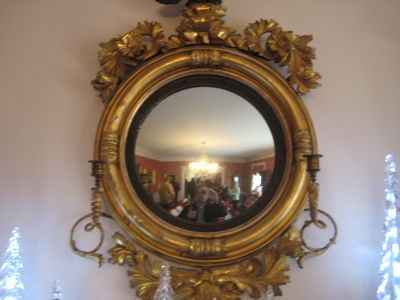
 Tom says
Tom says
December 9, 2010 at 12:56 pmI for one do find it fun that the houses on the left are in Hartford and the ones on the right are in West Hartford.
 Steve says
Steve says
December 9, 2010 at 1:42 pmThe truly “funny” part is that those who live on the Hartford side have the Hartford public school system to send their kids to (one of the worst in the country) and those on the West Hartford side have the West Hartford school system – said to be one of the best.
Of course, no kid in these houses goes to public shcool in Hartford. Ever. Ever.